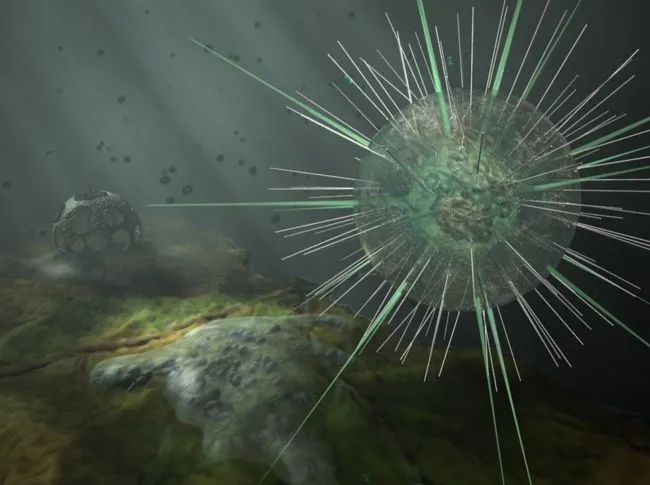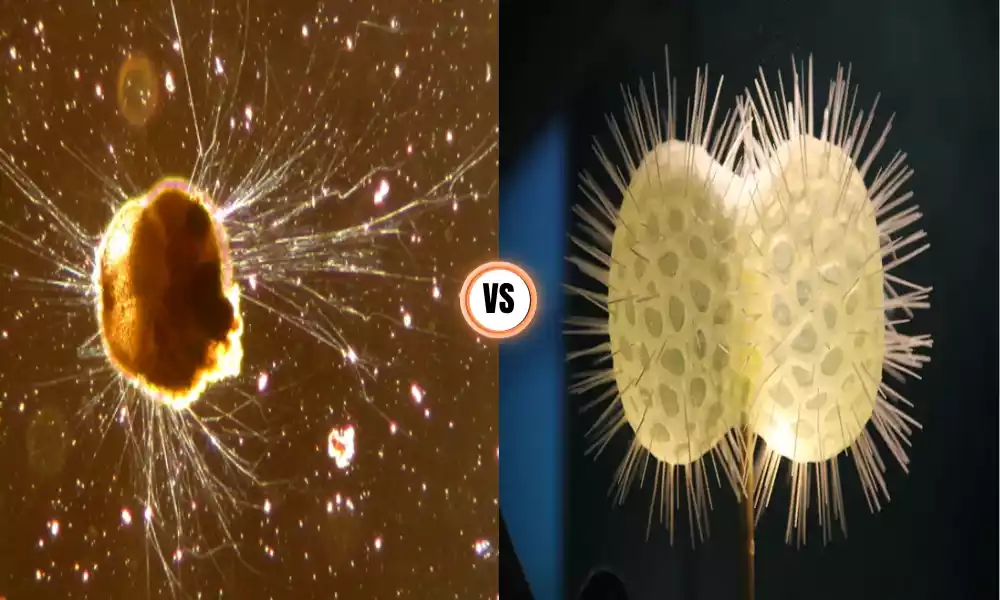Foraminiferans and Actinopods are two distinct groups of microscopic aquatic protists that play significant roles in marine and freshwater ecosystems. Foraminiferans are characterized by their intricate, calcium carbonate shells and pseudopodia, which they use for feeding and locomotion. They are vital environmental indicators and have a rich fossil record used in geological studies.
Actinopods are known for their siliceous skeletons and radiating axopods, and they exhibit diverse predatory and feeding strategies. Both groups contribute to the ecological balance of aquatic environments and have implications in fields ranging from ecology to paleontology. Understanding their differences is essential for appreciating their unique roles in the microscopic world.
What is Foraminiferans?
Foraminiferans, often referred to simply as forams, are a group of single-celled, aquatic protists belonging to the phylum Foraminifera. These microscopic organisms are characterized by their distinctive shells, called tests, which are typically made of calcium carbonate. Foraminiferans are found in various aquatic environments, including marine and freshwater habitats, and even in some terrestrial ecosystems.

One of the most remarkable features of foraminiferans is their pseudopodia, which are thread-like extensions of their cell body used for various functions such as capturing food particles, locomotion, and constructing their intricate tests. These pseudopodia can extend through small openings in the test, allowing the foraminiferan to interact with its surroundings.
Foraminiferans play essential roles in marine food webs, as they are often herbivores or detritivores, feeding on microorganisms and organic matter. Additionally, their calcium carbonate tests contribute to the formation of sediments on the ocean floor, and they have a significant fossil record that aids in paleontological and geological studies, helping scientists understand past environmental conditions and the history of Earth’s oceans.
What is Actinopods?
Actinopods, also known as radiolarians, are a group of single-celled, marine protists belonging to the phylum Radiolaria. These microscopic organisms are characterized by their intricate and delicate siliceous skeletons, which are often elaborately structured and resemble miniature works of art. Actinopods are primarily found in marine environments, especially in the pelagic (open ocean) zone, where they are a significant component of plankton.

The defining feature of actinopods is their axopods, which are long, slender, and often branched cytoplasmic extensions radiating from the central cell body. These axopods are used for capturing prey, buoyancy control, and locomotion. Actinopods are primarily heterotrophic, meaning they feed on smaller planktonic organisms by engulfing them using their axopods.
Actinopods play important ecological roles in marine ecosystems by participating in marine food webs and cycling nutrients. They are an essential component of zooplankton communities and are preyed upon by various marine organisms, including larger planktonic species and filter-feeding animals.
Due to their unique and intricate skeletal structures, the fossil record of actinopods is extensive and has been used for paleontological research and biostratigraphy, helping scientists understand Earth’s geological history and past oceanic conditions.
Comparison Table of Foraminiferans and Actinopods
Here’s a comparison table of Foraminiferans and Actinopods (Radiolarians) based on key characteristics:
| Characteristic | Foraminiferans | Actinopods (Radiolarians) |
|---|---|---|
| Taxonomy and Classification | Phylum: Foraminifera | Phylum: Radiolaria |
| Shell Composition | Typically calcium carbonate (CaCO3) | Siliceous skeletons |
| Morphology | Elaborate, chambered shells (tests) | Complex, intricate siliceous skeletons |
| Pseudopodia | Used for feeding and locomotion | Axopods radiating from the cell body |
| Habitat and Distribution | Marine and freshwater environments | Mainly marine, pelagic environments |
| Feeding Strategy | Heterotrophic, feeding on microorganisms | Heterotrophic, capturing prey with axopods |
| Reproduction | Asexual and sexual reproduction | Asexual and sexual reproduction |
| Ecological Roles | Contribution to marine food webs, environmental indicators | Planktonic organisms, part of marine food webs |
| Geographic Distribution | Worldwide, various aquatic ecosystems | Mainly in pelagic zones of oceans |
| Geological Significance | Important in the formation of marine sediments, rich fossil record | Extensive fossil record used in paleontology and biostratigraphy |
| Research Applications | Used in ecological and geological studies | Important for understanding past ocean conditions and biodiversity |
This comparison table highlights some of the key differences and similarities between Foraminiferans and Actinopods, emphasizing their taxonomic classification, morphology, ecological roles, and scientific significance.
Ecological Roles and Significance
Ecological roles and significance refer to the functions and importance of various organisms, species, or ecological processes within ecosystems and the broader environment. Understanding these roles is crucial for maintaining ecological balance, biodiversity, and the overall health of ecosystems.
Here are some key aspects of ecological roles and their significance:
- Biodiversity Maintenance: Different species play unique roles within ecosystems. Biodiversity, the variety of species in an ecosystem, ensures its resilience and stability. Each species contributes to ecosystem functions and services, such as nutrient cycling, pollination, and pest control.
- Nutrient Cycling: Many organisms, such as decomposers (e.g., bacteria and fungi), play essential roles in breaking down organic matter, returning nutrients like carbon, nitrogen, and phosphorus to the soil, and making them available to plants. This recycling of nutrients is crucial for plant growth and overall ecosystem health.
- Pollination: Pollinators like bees, butterflies, and birds are vital for the reproduction of many plant species, including numerous crops. They facilitate the transfer of pollen between flowers, ensuring the production of fruits and seeds.
- Predator-Prey Relationships: Predators help control the populations of prey species, preventing overpopulation and maintaining ecological balance. These interactions also influence the distribution and behavior of species within ecosystems.
- Keystone Species: Some species are considered “keystone species” because their presence has a disproportionately large impact on their ecosystem. Their removal can lead to significant changes in the structure and function of the entire ecosystem. For example, sea otters in kelp forests help maintain the health of these ecosystems by controlling sea urchin populations, which otherwise overgraze kelp.
- Ecosystem Engineers: Certain species, often referred to as ecosystem engineers, physically modify their habitats, creating conditions suitable for other organisms. Examples include beavers building dams that create wetlands and coral reefs providing habitat for numerous marine species.
- Carbon Sequestration: Plants, especially trees and forests, play a crucial role in sequestering carbon dioxide from the atmosphere. This helps mitigate climate change by reducing greenhouse gas concentrations.
- Water Purification: Wetlands and aquatic ecosystems act as natural filters, removing pollutants and purifying water. They help maintain water quality and support a wide range of aquatic life.
- Human Dependence: Ecosystems provide numerous goods and services essential for human well-being, such as food, clean water, medicine, and raw materials. The loss or degradation of these ecosystems can have dire consequences for human societies.
- Scientific Understanding: Studying ecological roles and relationships helps scientists better understand the complex interactions within ecosystems. This knowledge informs conservation efforts, ecosystem management, and policy decisions aimed at preserving biodiversity and ecosystem services.
- Cultural and Aesthetic Value: Ecosystems and their inhabitants have cultural and aesthetic value for humans. They inspire art, literature, and recreation, contributing to our sense of place and connection to the natural world.
Ecological roles and their significance are fundamental to the functioning of ecosystems and the well-being of both natural and human systems. Recognizing and preserving these roles is essential for sustainable management and the conservation of Earth’s biodiversity and ecological services.
Paleontological Importance
Paleontological importance refers to the significance of fossils and the study of ancient life in understanding Earth’s history, evolutionary processes, and past environments. Paleontology, the scientific discipline dedicated to the study of fossils, plays a crucial role in unraveling the mysteries of life on Earth.
Here are several key aspects highlighting the paleontological importance:
- Reconstruction of Past Life: Fossils are the preserved remains or traces of ancient organisms. They provide direct evidence of the types of organisms that lived in the past, helping scientists reconstruct the evolutionary history of life on Earth.
- Dating Geological Strata: Fossils serve as valuable markers for dating geological layers, a process known as biostratigraphy. By examining the fossils found in rock layers, paleontologists can determine the relative ages of rocks and create a chronological framework for Earth’s history.
- Evolutionary Insights: Fossils offer insights into the evolutionary processes that have shaped life over millions of years. Comparative anatomy and the study of transitional fossils provide evidence for the evolution of species and the development of new traits.
- Extinction Events: Fossil records reveal past mass extinctions, such as the Cretaceous-Paleogene (K-Pg) extinction event that wiped out the dinosaurs. Understanding these events helps scientists comprehend the causes and consequences of major extinction events.
- Climate and Environmental Change: Fossils can indicate past environmental conditions and climate. For example, the presence of certain plant fossils can suggest the presence of ancient forests, while the types of fossils found in sedimentary rocks can provide clues about past ocean temperatures and ecosystems.
- Biogeography: Fossil distributions across continents and regions help scientists understand the movement of species and the formation of biogeographic patterns over geological time scales.
- Human Evolution: Paleontology has played a critical role in the study of human evolution. Fossilized hominid remains provide crucial insights into the ancestry and development of the human species.
- Resource Exploration: Fossils, particularly those of ancient plants and marine life, have economic significance in industries like petroleum exploration and coal mining. They help identify the presence of fossil fuel deposits.
- Education and Outreach: Fossils captivate the public’s imagination and play a vital role in science education and outreach. They inspire curiosity about Earth’s history and the diversity of life that once inhabited our planet.
- Conservation: Understanding past ecosystems and extinction events can inform conservation efforts today. It highlights the importance of preserving biodiversity and protecting ecosystems to prevent future extinctions.
- Interdisciplinary Research: Paleontology often involves collaboration with other scientific disciplines, such as geology, chemistry, and genetics, leading to a deeper understanding of Earth’s history and the life that inhabited it.
Paleontology is instrumental in uncovering the rich tapestry of Earth’s past, shedding light on the evolution of life, ancient environments, and the geological forces that have shaped our planet. It provides invaluable insights into the history of life and contributes to our understanding of contemporary ecological and environmental challenges.
Research and Scientific Discoveries
Research and scientific discoveries are fundamental components of the advancement of human knowledge and technology. These processes encompass a wide range of activities that aim to explore, understand, and explain the natural world, physical phenomena, and human behavior.
Here are some key aspects and examples of research and scientific discoveries:
- Basic Research: Basic research seeks to expand our fundamental understanding of the world around us. It often leads to discoveries that may not have immediate practical applications but lay the foundation for future breakthroughs. For example, research in particle physics led to the discovery of the Higgs boson, advancing our understanding of the fundamental forces governing the universe.
- Applied Research: Applied research focuses on solving specific problems or developing practical solutions. It often takes the knowledge gained from basic research and applies it to real-world challenges. For instance, research in materials science has led to the development of stronger and lighter materials used in aerospace and construction.
- Interdisciplinary Research: Many significant discoveries occur at the intersection of different scientific disciplines. Fields like bioinformatics, which combines biology and computer science, have led to breakthroughs in genomics and drug discovery.
- Technological Advancements: Scientific discoveries often lead to technological innovations. For instance, the discovery of the structure of DNA laid the groundwork for genetic engineering techniques like CRISPR-Cas9, which revolutionized genetic research and medicine.
- Medical Research: Advances in medical research have led to the development of vaccines, antibiotics, and medical procedures that have saved countless lives. The discovery of antibiotics like penicillin by Alexander Fleming is a famous example.
- Environmental Research: Scientific research has played a crucial role in understanding and addressing environmental issues, such as climate change. Discoveries in climate science have led to increased awareness and efforts to mitigate the impacts of global warming.
- Space Exploration: Space agencies like NASA conduct extensive research that leads to discoveries about our solar system and beyond. Discoveries like the presence of water on Mars have significant implications for future space exploration.
- Social and Behavioral Sciences: Research in psychology, sociology, and economics has contributed to our understanding of human behavior and societal dynamics. Behavioral economics, for example, has influenced public policy and business practices.
- Computational Research: Advances in computing technology have enabled sophisticated simulations and modeling in various scientific fields, accelerating research and discovery processes.
- Global Collaboration: Many groundbreaking discoveries involve collaboration among scientists and researchers from around the world. Large international projects like the Large Hadron Collider (LHC) exemplify global cooperation in scientific research.
Research and scientific discoveries are essential drivers of progress and innovation in various fields, enriching our understanding of the world, improving our quality of life, and addressing pressing global challenges. These discoveries often have far-reaching implications, shaping the course of human history and the future of our planet.
What are the similarities between Foraminiferans and Actinopods?
Foraminiferans and Actinopods (Radiolarians) are both groups of microscopic aquatic protists, and despite their differences, they share some similarities:
- Microscopic Size: Both Foraminiferans and Actinopods are unicellular organisms, and they are typically quite small, often ranging from a few micrometers to a few millimeters in size.
- Aquatic Habitats: Both groups primarily inhabit aquatic environments. While Foraminiferans can be found in both marine and freshwater ecosystems, Actinopods are mainly found in marine environments, particularly in the pelagic zone.
- Heterotrophic Feeding: Both Foraminiferans and Actinopods are heterotrophic, meaning they obtain their nutrition by feeding on other microorganisms. They capture and consume small planktonic organisms and organic particles in the water.
- Microscopic Structures: Both groups have specialized structures that aid in their ecological functions. Foraminiferans have pseudopodia used for feeding and locomotion, while Actinopods have axopods, which serve similar functions.
- Ecological Roles: Foraminiferans and Actinopods play vital roles in marine ecosystems. They are part of planktonic communities and contribute to marine food webs by serving as prey for various organisms and participating in nutrient cycling.
- Fossil Record: Both Foraminiferans and Actinopods have extensive fossil records, which are used in paleontological and geological research to understand past environmental conditions and the history of Earth’s oceans.
- Research Importance: Both groups are subjects of scientific research due to their ecological significance and the valuable information they provide in fields like ecology, paleontology, and biostratigraphy.
While these similarities exist, it’s important to note that Foraminiferans and Actinopods also have significant differences, particularly in their shell composition, morphology, and ecological niches. These distinctions make each group unique and suitable for specific ecological roles.
Final Thoughts
Foraminiferans and Actinopods, though both belonging to the realm of microscopic aquatic protists, exhibit distinct characteristics and ecological roles. Foraminiferans are recognized for their calcium carbonate shells, while Actinopods boast intricate siliceous skeletons. Despite these differences, both groups share microscopic size, heterotrophic feeding strategies, and play integral roles in marine ecosystems.
Their fossil records are invaluable for understanding Earth’s history. These similarities and differences make Foraminiferans and Actinopods captivating subjects of scientific study, shedding light on the complex and diverse microcosm of life in our planet’s waters.



